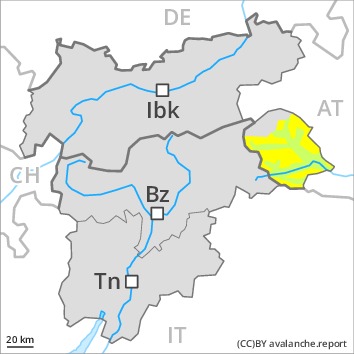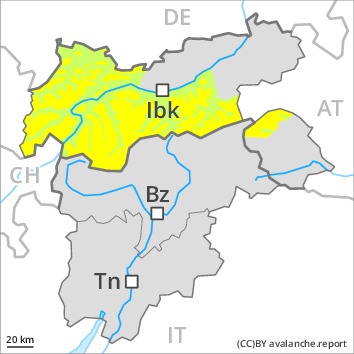
Danger level
 | treeline
|
Avalanche Problem

Wind slabs require caution.
Wind slabs can as before be released, even by a single winter sport participant, especially adjacent to ridgelines and in gullies and bowls above the tree line. Avalanches can in isolated cases penetrate deep layers and reach large size.
A latent danger of gliding avalanches exists. Areas with glide cracks are to be avoided as far as possible.
Snowpack
dp.6: cold, loose snow and wind
The various wind slabs have bonded poorly together. As a consequence of low temperatures the snowpack could settle hardly at all.
Faceted weak layers exist in the centre of the snowpack in particular above the tree line. This applies in all aspects.
Towards its base, the snowpack is moist and its surface has a melt-freeze crust, in particular at low and intermediate altitudes.
Tendency
The avalanche danger will persist.

Danger level
 | 1600m
|
Avalanche Problem
 | | Wind-drifted snow |
|  | |  |
 | | Persistent weak layer |
|  | |  |

Wind slabs and weakly bonded old snow require caution.
Wind slabs can still be released by a single winter sport participant. The avalanche prone locations are to be found in particular in gullies and bowls, and behind abrupt changes in the terrain above approximately 1600 m. The number and size of avalanche prone locations will increase with altitude. Avalanches can in isolated cases penetrate deep layers and reach large size.
Dry avalanches can additionally in isolated cases be released in the weakly bonded old snow by small loads, especially at transitions from a shallow to a deep snowpack, when entering gullies and bowls for example. These avalanche prone locations are barely recognisable, even to the trained eye. They are to be found in particular on west to north to east facing aspects above approximately 2000 m.
Snowpack
dp.6: cold, loose snow and wind
dp.7: snow-poor zones in snow-rich surrounding
The fresh and older wind slabs are lying on soft layers above approximately 1600 m.
Avalanche prone weak layers exist in the centre of the snowpack, especially between approximately 2000 and 2400 m on steep west, north and east facing slopes.
Tendency
As a consequence of new snow and a sometimes strong northwesterly wind, further wind slabs will form.

Danger level
 | 1800m
|
Avalanche Problem

Wind slabs require caution.
The wind slabs of the last few days remain for the foreseeable future prone to triggering above the tree line. The avalanche prone locations are to be found in particular adjacent to ridgelines and in gullies and bowls. These places are clearly recognisable to the trained eye.
Weak layers in the old snowpack can still be released in very isolated cases by individual winter sport participants. This applies at high altitude, in particular in the Western Kitzbühel Alps.
Snowpack
dp.6: cold, loose snow and wind
In some cases the various wind slabs have bonded still only poorly together. As a consequence of low temperatures the snowpack can not consolidate. Individual weak layers exist in the centre of the snowpack. At low altitude a little snow is lying.
Tendency
Slight increase in avalanche danger as a consequence of new snow and strong wind.









